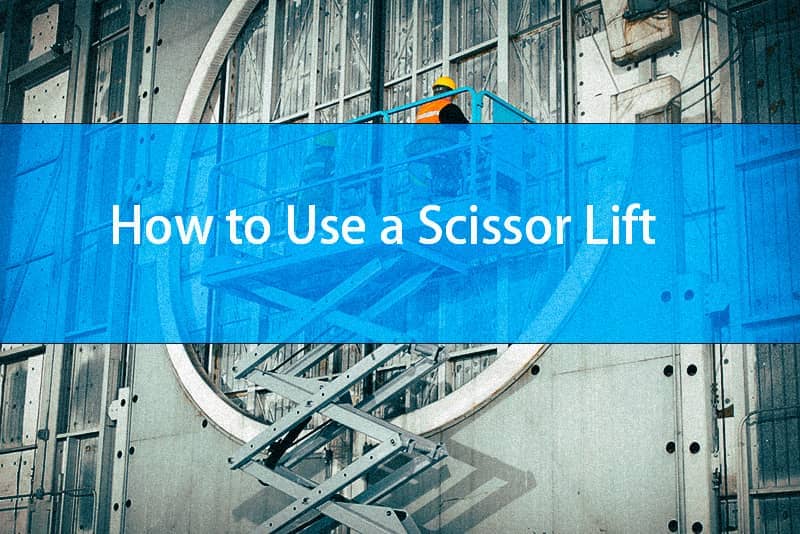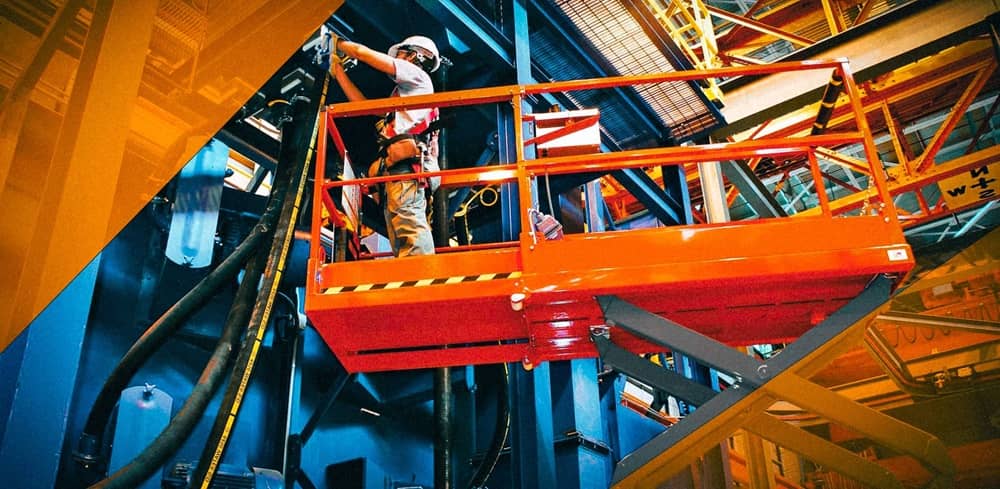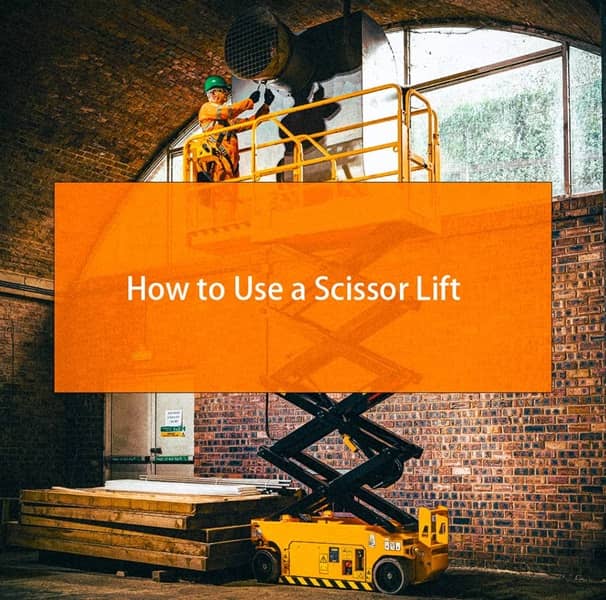Scissor lifts are very versatile equipment that have changed work at height in almost every industry. They are mobile elevated work platforms and derive their name due to pairs of crossed metal support that extends upwards so as to lift the platform for work, looking like a scissor. Usually hydraulic, scissor lifts can rise vertically from a few feet to more than 50 feet, depending on the make and model.
In this guide, Holdwell will let you know how to use a scissor lift in a safe and productive manner clearly and briefly. Beginning with pre-operation checks, proper operational procedures, and important safety measures to be taken, we include all details necessary for you to be a responsible and cautious machine operator who understands the process well.

Before You Begin: Essential Pre-Operation Checks
Before the operation of a scissor lift, it is factored by maintaining safety, which begins when you have yet to turn the key. The pre-operation inspection is very important to make sure the equipment is working fine, and also to avert any possible accidents that might occur due to malfunction during use.
Visual Inspection:
Initiate your pre-operation practice with a thorough visual inspection of the scissor lift. It is imperative in identifying any apparent issues that could compromise safety or performance:
1. Pay attention to the bodywork for dents, cracks, or rust.
2. Look for leaks in the hydraulics; this may be evident as puddles under the machine or wet patches on some components.
3. Check that all tires are correctly inflated and ensure there are no obvious signs of wear or damage.
4. Ensure that all guardrails and safety bars are firmly fixed and free from damage.
Observe that all emergency stop buttons are clearly visible, accessible, and in good working order.
Check for loose, missing, or damaged components that could affect the operation of the lift.
Functional Checks:
Having carried out the visual inspection, proceed to test the scissor lift’s key functions:
1. Operate all controls to ensure they respond immediately and operate smoothly. This includes platform elevation and descent, steering, and any other modes of movement.
2. Ensure that the electric scissor lifts are adequately charged. Fuel-powered scissor lifts should be filled with enough fuel to cover the duration of work planned on them.
3. Before operation, test the emergency lowering system to check its effective functioning.
4. Check the platform of the scissor lift properly. It should be clean, dry, and free from any materials that can cause tripping.
Safety Equipment:
During the operation of a scissor lift, it is mandatory to wear PPE. The equipment that you should have and wear at all times during the operation includes the following:
1. A hard hat to be used to protect against falling objects
2. Safety glasses for eye protection against debris
3. Work gloves to have a better grip as well as protect hands
4. Steel-toe boots for foot protection
5. High-visibility vest especially at work within a vehicle traffic area
Clear the Area:
Before work, inspect the work area:
– Check and clear the site of any obstacles or debris that might impede the scissor lift’s movement.
– Note any possible causes of danger, for example, uneven ground, holes, or soft spots that might affect stability.
3. Inspect overhead obstructions such as power lines, beams, or light fixtures.
4. Confirm there is enough clearance around the lift for all possible extensions it has available.
5. For outdoor work, gauge the weather forecast and delay work if it includes high winds or severe weather.
By performing these pre-operation checks diligently, you set the stage for a safe and efficient work session with your scissor lift. Remember, the time you take to inspect your equipment and prepare properly is an investment in your safety and the success of your project.
Operating the Scissor Lift: Step-by-Step Guide
Read the Manual:

Before operating any scissor lift, one must read and understand the manufacturer’s manual for the specific model to be used. There could be variations in features, safety mechanisms, and procedure for operation of different scissor lifts. Therefore, attention to detail in acquaintance with such information is of utmost importance for safe and effective use.
Getting Started:
1. Mounting and Dismounting:
• Always use three-point contact at all times when mounting or dismounting from the platform.
• Face the lift and maintain contact using both hands and one foot, or both feet and one hand.
• At no time must you jump on to or off the platform.
2. Safety Chain or Gate:
• Once you have reached the platform, immediately fasten the safety chain or gate.
• Start no work until assured it is securely latched.
3. Emergency Brake:
• Before lifting the platform, apply the emergency brake.
• This way, there will not be any surprise movement as you are working at height.
Controls and Operation:
Learn the basic controls of the scissor lift:
1. Raising/Lowering:
• Controlled by a joystick or buttons.
• Practice a smooth and gradual shift to eliminate jerking.
2. Steering:
• Controlled by a joystick or steering wheel.
• Know the turning radius and any tail swing.
3. Emergency Stop:
• Find the red button marked “Emergency Stop.”
• Know how to make it work so that it can be done quickly in an actual emergency.
Remember controls may vary between models therefore always refer to the specific instructions for your lift.
When maneuvering the scissor lift:
– Start with the platform as low as possible for greater stability.
– Always keep a lookout in the direction of travel and be constantly aware of your surroundings.
– Move slowly and steadily; no sudden jerks.
– Caution regarding ground conditions- no uneven surfaces, holes, or debris.
5. HGV Reverse Assistant: If possible, have a spotter guide you when moving in tight spaces or areas with limited visibility.
Working at Height:
Simone the platform is elevated:
1. Maintain Stability:
• Keep the platform level at all times.
• Do not reach out beyond the railing of the platform.
• Distribute weight uniformly on the platform.
2. Avoid Sudden Movements:
• When shifting tools or materials, make sure to do so carefully to keep from upsetting the balance.
• Do not shove or pull against adjoining structures; it will cause instability.
3. Stay Within the Railings:
• Do not climb or lean over the guardrails.
• Ensure that both feet are kept squarely on the platform floor.
Weight Restrictions:
Knowing and abiding by the lift’s weight capacity will ensure safety during operation:
1. Know Your Limits:
• The maximum load capacity should be highlighted on the lift.
• Calculation shall include the sum of the weights of persons, tools, and material to be carried.
2. Hazards of Overloading:
• Exceeding weight limits can cause the lift to tip over or fail.
• It may also compromise the structural integrity of the lift or its hydraulic system.
3. Even Distribution:
• The weight should be uniformly distributed over the platform.
• Do not put all the weight on one side or in one corner of the platform.
Effective operation of a scissor lift and risk reduction can be achieved through operating it according to these guidelines step by step and always giving priority to safety. Keep in mind that proper operation guarantees your safety as well as the safety of those around you at work and also contributes to a longer life for the equipment.

Common Mistakes & Safety Precautions
Proper comprehension and avoidance of common mistakes in addition to strictly adhering to crucial safety precautions are required to guarantee safe scissor lift operation. Save for excerpts that bring out highlighted areas where operators often err, these provide important safety measures that need to be adopted to avert accidents.
Common Mistakes:
1. Overloading the Lift:
• Mistake: Excessive number of workers, tools, or materials, surpassing the lift’s weight capacity.
• Consequences: May tip over, structural damage, or mechanical failure.
• Prevention: Make sure you never attempt to drive or operate the lift on slopes uneven ground, or unstable ground. Include all personnel, equipment, and materials in your total load to be cautious.
2. Moving on Uneven Surfaces:
• Mistake: Driving or operating the machine on slopes, bumpy terrain, or unstable ground.
• Consequences: Tip over or lose control.
Strict guidelines of what not to rewrite:
Do not use colloquial terms, do not introduce any incorrect spellings, and do not insert gibberish. Do not lose any information while carrying out the rewriting exercise. Make sure no addition, omission, or repetition occurs. Ensure the word count does not go beyond that of the original. Do not add asides or cliches unless they appear in the original text. Do not end sentence fragments with question marks unless there is already a question mark in the original.
• Prevention: Ensure that scissor lifts are used only on surfaces that are flat and level. If rough ground cannot be avoided, then rough-terrain lifts should be used plus whatever other guidelines the manufacturer has.
3. Not Wearing Proper Safety Gear:
• Mistake: Operating the lift without personal protective equipment (PPE).
• Consequences: Increased risks of falls, falling objects, and other hazards to an injury.
• Prevention: The operator shall wear at all times proper PPE, including hard hats and safety glasses and shall comply with required fall protection for harnesses.
4. Attempting Repairs Without proper Training
• Mistake: Attempts to repair mechanical faults or bypass safety features without authority and expertise.
• Consequences: Possible damages to equipment, cancellation of warranties, and most importantly, very serious risks in safety.
• Prevention: Repairs or modifications should be made by technically able personnel. Any problem detected should be urgently relayed to supervisors.
Crucial Safety Precautions:
1. Do Not Ever Use the Lift as a Crane:
• The scissor lift is purposely meant to lift people and light materials, never to use it to lift heavy loads.
– It is hazardous to use the lift as a crane; such an attempt can cause tipping or structural failure.
– Always use proper material handling equipment for lifting and moving heavy items.
2. Overhead Obstructions Probability:
– Always check for power lines, pipes, beams, or other overhead hazards before raising the platform.
– Maintain a minimum safe distance from power lines as specified by safety regulations; normally, that distance should exceed ten feet.
Precautionary Measure:
• Use a spotter if needed to help identify potential overhead risks.
Maintain Safe Distancing:
• Keep the lift at 3 feet from other equipment, vehicles, and fixed objects.
• Ensure there is enough clearance for the lift’s movement and any potential tail swing.
• Create a work zone around the lift and do not allow unauthorized people to enter that area.
Other Complete Safety Precautions:
4. Weather Conditions:
• Do not operate scissor lifts in winds of 28 mph or more (check manufacturer specifications).
• Do not use during electrical storms or heavy rain.
5. Inspections and Maintenance:
• Perform a pre-use inspection daily to identify obvious damage or mechanical problems.
• Ensure that periodic maintenance is performed as scheduled by the manufacturer.
6. Training and Certification:
• Only use trained and certified personnel for scissor lift operations.
• Ensure the operators receive refresher training at regular intervals.
7. Emergency Preparedness:
• Familiarize yourself with the emergency lowering procedure.
• Always have a rescue plan available for the case of equipment failure or operator incapacitation.
By avoiding these common mistakes and adhering to these safety precautions with every confidence, the operators can significantly reduce the risks of accidents and injuries that come with using the scissor lift. After all, safety should always be the top priority when working with any type of aerial lift equipment.
If you are thinking of buying a used scissor lift or need more information on proper operations and maintenance procedures, then Holdwell would be the right choice. As experienced dealers in used lifts, we can offer the following:
• Advice from specialists on selecting the most appropriate scissor lift for your requirements
• Detailed history and condition of our used lifts
• How to operate them correctly and the proper safety procedures
• Repairs and maintenance support
Never hesitate to contact Holdwell regarding all your scissor lift requirements. A knowledgeable team will help find the perfect used lift for your projects and ensure you have all the information required for safe and effective operation. Get in touch with us today to find out more about our inventory and services!




